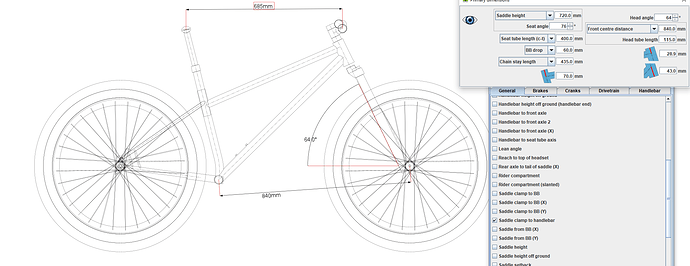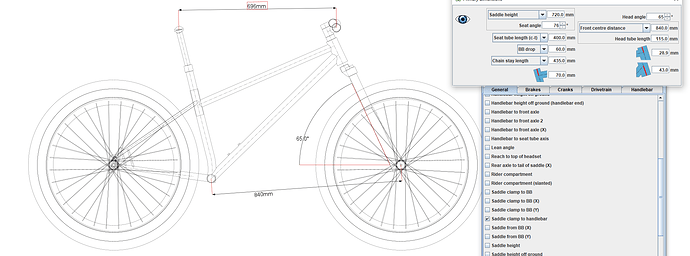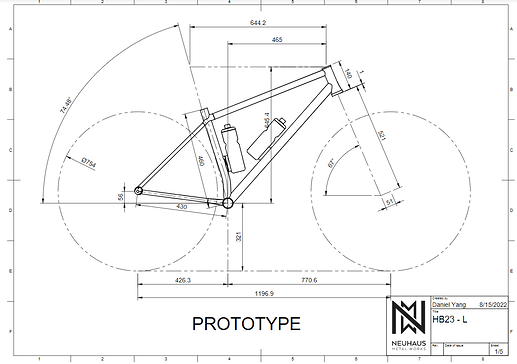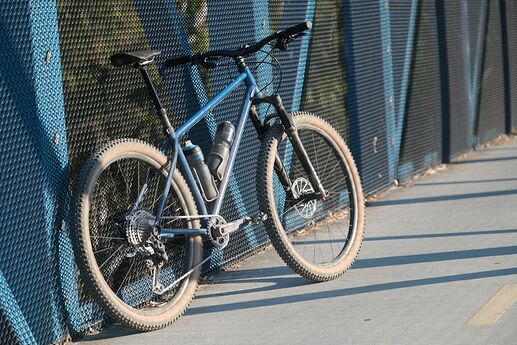I just finished listening to the podcast that started it all and it sounds like @Daniel_Y wanted all the contentious topics posted draw all the lurkers into posting so here goes.
What are your driving dimensions and why?
My 2 main driving dimensions are:
1 - Wheelbase - I think that the wheelbase of the bike has the biggest effect on rate of turning and stability.
2 - Front centre to rear centre ratio - I think that this ratio determines the default balance between front and rear traction when cornering. I say default because you can change this with handlebar height, stem length etc. to move the hand grip location.
Past this the seat tube angle and all that kind of jazz is manipulated to make the cockpit feel how I want it to, getting the saddle in the right location for comfortable pedaling etc.
I have not really figured out what exactly I want in terms of stack height, more data required here. I keep spreadsheets of all the bikes that I spend any decent amount of time riding with geo and riding impressions.
I still have a whole lot of experimenting to do so I haven’t properly settled on my formula so I would be interested to see how other people go about deciding on what matters and why they think it matters.
I also think that there is a large degree of personal preference here so there is no right and wrong, mostly I would like to know what your goals are and how you are achieving them.
3 Likes
Not to be pedantic, but do you mean “driving” instead of “driven?” At least in my line of work driving parameters are those which you explicitly set, and driven parameters are those which are set as a result of your driving parameters.
In my last few builds, the order of driving parameters has been this:
- horizontal distance between saddle rail clamp center and crank axis of rotation. As far as I can tell, this is set by anatomy. My knee tends to explode if I place the saddle too close to the BB in the horizontal direction.
- front center. Many experienced people say more is good, I’m still figuring out how much and why.
- flop. I hate it. I want to avoid it if at all possible.
Nothing set in stone, no hills to die on. Just what I’ve been working with lately. I’d like to experiment with rear center next.
3 Likes
All the fit dimensions are just a function of where the rider likes their hands/butt/feet. So there’s no designing to do.
I spend a lot of time on front/rear center - weight balance stuff. That and steering trail are the big numbers I care about.
That said, a lot of mountain bikers simply won’t accept a frame that requires them to use a >40mm stem, and also want really short chainstays, so sometimes your hands are tied.
-Walt
4 Likes
Agreed! For my height 6’1, I have a pretty tall saddle height (785mm) due to long femurs. With a 75STA (static) and short cranks (170mm), I get this odd pressure like my knee wants to pop. The pain went away when I switched to 175mm cranks.
People obsess over STA’s when they really should be comparing femur lengths (please don’t haha)
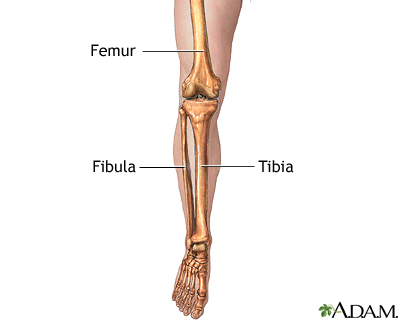
I have a longer thesis on bike design, ill type it up over the next few days. I just wanted to chime into the knee pain discussion, because I can relate.
2 Likes
Oh yes, whoops. Driving. Have fixed now
I agree with the seat tube angle conversation here, I suspect its a holdover from ye olde days. X/Y coordinates for the win.
The flop is an interesting one @sunshine.fab, is this on a mountain bike or something else and what would you consider to be too much?
1 Like
@Pi_bikes So far my beef with flop has been on mountain bikes (I’ve yet to stray from traditional road bike geometries on road bikes). From what I can tell, the exact mechanism of flop is slightly nebulous. But I think I’m getting somewhere. I think it’s more about the ratio of trail/flop height to distance between front contact patch and COM than it is about choosing a particular number in isolation. I think there’s enough setup and explanation for this topic to warrant a separate discussion post, so that’s all I’ve got on design for now. I’ll try to port some of my thinking into a new discussion post this week.
To me, flop is a feeling and too much of it is when I feel like intrinsic characteristics of the bike I am on make it hard for me to hold the front wheel in the direction I want at the slow speeds I encounter while climbing steep and/or technical trails.
2 Likes
Flop is mostly just about not having enough weight on the front wheel, in general. You can simulate this in any number of ways if you want to prove it to yourself with both bikes and non-bike wheeled things. If you get aggro enough getting your weight forward, you can keep even a full DH sled going straight uphill at low speeds if you really want to.
High trail/long front center modern mountain bikes have mostly tried to solve this by steepening seat angles, and in some cases using slightly longer chainstays.
-Walt
1 Like
Great topic! I feel like driving dimensions are more like a cascade. You first get the rider’s contact points set and then move to the front end and then the back end.
To get the rider sorted, I use bb to saddle clamp X and Y, bb to hands, and bb to hand angle.
To take care of the handling, it seems basic, but I rely on head tube angle. Customers typically already know what handlebar, fork, and front tire they want to use. That limits the ability to mess with trail and flop other than with the head tube angle. If you’re lucky enough to work with a customer who is open to experimenting, then you can get wild. For instance, handlebar dimensions can make a drastic change to the design.
Even HTA is in a pretty small window of adjustment, from 64º to 68º. HTA with the components determines front center. Front center informs chainstay length. Then I adjust BB height to the rider’s terrain and preferences.
It’s pretty cool reading the other responses so far. Everyone has a slightly different workflow.
3 Likes
Sam from Naked sent me a few emails of fit advice / geometry advice when I first started designing. I still email him from time to time when I feel anxious about a design (hope you liked the coffee, Sam).
In essence his advice was:
The rider contacts the bike in three places: pedals, seat, handlebars.
Figuring out where these contact points need to be in space is the hard part. Deciding geometry of what is beneficial for the rider is the easier part.
For context I only do bespoke right now, but am trying to change to models, with a bespoke option being pricier and also introducing a longer wait time.
I spend a lot of time with the rider discussing the ride experience they want. Maybe they are great at going downhill but could use some help going uphill. So, designing a better climbing bike rather than a downhill bike can be beneficial for them.
I almost always design around a 42mm stem. They can go shorter if they want but most riders can’t tell the difference between 42 and 35mm (even 31mm) stems. I also always recommend 170/165/160mm cranks with an extra push for 160mm for the majority of people. I design primarily in bikecad and use front center / head tube length as my main parameters. I typically end up with a 64 degree HTA, 76-77 degree STA. HTA doesn’t control front center in this context so I primarily use HTA to dictate where the bars will land. I find that designing in this context means that HTA isn’t a particularly important angle. Obviously it can’t be 90 degrees, but 64-67 on a progressive MTB is just fine.
I’m confused, how do you use HTA to determine where the bars end up? I mean, there’s some minor effect there but it’s not much.
Given a 40mm stem and a desired cockpit length, you’d adjust the reach of the frame to change bar position, right? Or did I not understand something? And if you’ve got a fixed reach/stem length for every rider, how is it that the HTA doesn’t change the front center? On most bikes a degree of HTA is going to change front center by at least 10mm, and sometimes considerably more if it’s a longer suspension fork.
Maybe there’s a communication problem here but a bunch of that made no sense to me.
I personally just let the stem length end up at whatever it needs to be for the rider to get their hands where they want, after I’ve sorted the weight distribution/wheel positioning. But like I said, for a lot of people stem length is non-negotiable, so sometimes you have to just shrug and build something that’s probably not optimal.
-Walt
When designing in Bikecad I use Front center and HTL as two of my primary dimensions. When designing this way, front center is locked to what you set it at. I don’t use frame reach or frame stack when designing bespoke. Here is an example of a 65 degree head tube angle and a 64 degree head tube angle. Changing from 65 to 64 degrees does not change the front center but does change the saddle clamp to handle bar measurement by 11mm.
Personally, I don’t think HTA alone is very important in this context. It doesn’t really change how the bike rides at all, just how your body is positioned. The front center is more important as it dictates how long the bike is, how long the chainstays need to be, and HTL dictates ‘frame stack’ if you will. Desired riding style dictates front center length, along with fit information.
To add more information, here is one of the blurbs that Sam sent me:
"
- The body touches the bike in 3 points. Seat, grips and pedals.
- The bike touches the ground in two spots. both tires.
- Input at the body touch points is connected through various levers and pivots in order to effect a change what happens at the ground contact points.
- The same is true the other way. Input at the ground contact points will be translate to the body touch points.
- This is really all there is to it. Figuring out what those vectors between points should be is the hard/fun part. But, if you are going to figure out what is really going on you need to measure these points accurately and experiment.
- Things like stem length and TT length don’t mean anything by themselves. They need to be measured as part of a whole system. For example, The distance from the grips to the steering acces in both width and extension are very important, but bars are very different in shape and rotating them or cutting them changes them again. One set of bars with a 32 stem could be the same as another set of bars with a 50 stem.
- TT length also means nothing by itself. Once you have figured out where you want your grips and steering access combo to live in space and your saddle and pedals combo to live in space, the top tube is just the thing that connects the two.
- Now, for some MTB generalities:
- In general, most people like there grips in line with there steering axis or just in front.
- The more climbing and descending, the more forward the geo wants to be. The more flat and in saddle riding over longer duration, the closer to traditional road saddle position should be.
- Most people prefer a longer wheelbase these days. Chainstay length should be lengthened accordingly to maintain some weight on front wheel.
- Bar width seems to be linked to front and rear trail. The longer the trail values, the wider the bars."
2 Likes
I mean, I get it. But for a given front center and desired saddle-bars number, if you’re holding the stem length constant it could take a LOT of head angle (which does dramatically affect how the bike steers) to adjust the bar position.
I mean, say I have really long arms out of proportion to the rest of me. Are you really going to give me a 68 hta to get me reaching far enough to my bars?
-Walt
1 Like
@terraformbicycles I’m also curious how you use front center to drive the design. How do you determine the optimal front center ahead of time, by the rider’s body measurements and riding style? Like if a rider is such and such tall with such and such arm length and rides steep stuff, he gets 850mm front center? Then you factor in the components and use HTA and HTL to find the hand position?
Haha, it’s nearly opposite of what I do. I’m not saying your way doesn’t work, it’s just funny how there seems to be so many ways to dance.
1 Like
Walt, head tube angle is just one way of getting to the desirable saddle-bar number. Front center, stem length, HTL, headset spacers available, etc, are all factors too. I haven’t had a client be dead set on crank length or stem length yet.
@manzanitacycles generally my hard tails for people over 5’7 start in the 800mm range. I find going into that 800mm+ range is a sweet spot for really rocky areas. I don’t decide on the front center measurement first, it generally falls in line with what they want their ride experience to be, how tall they are, fit etc,.
1 Like
Some good discussion going on. Thanks for keeping everything civil.
As a tool to aid in discussion, I propose a parameter I look at: rear-front ratio (RFR).
Assumptions:
- Flat ground
- weight is through the bottom bracket (ie. standing up)
Rear wheel force: F1 = L2/(L1+L2) * Mg
Front wheel force: F2 = L1/(L1+L2) * Mg
The rear/front ratio is really easy to calculate because most of the terms cancel themselves out:
rear-front ratio: RFR = F1/F2 = L2/L1
To put it in words: you divide the front center by the rear center, giving you the ratio of the weight on the rear and front wheels. For example, an RFR of 1.85 means the rear wheel has 1.85x the weight of the front wheel.
Here is the spread for our Hummingbird frame:

In my experience, I have found bikes with a ~1.88-1.9 RFR to be on the margin of “well-rounded” for how I like to ride. It’s fun to descend, but I really need to be mindful of flat corners and tight switchbacks. It was much harder to ride when I was fatigued or riding blind on a natural trail.
Right now I have been enjoying a bike with a (GASP) 67deg headtube angle (unsagged!), with an RFR closer to 1.81.
The rear-front ratio is just one parameter I look at. I don’t have any overarching design law that I follow (aside from good bike fit).
1 Like
Um, yeah, but you said you always use a 40mm stem, right? That’s what you said back in your first post. Then you said you use HTA to adjust rider cockpit:
“I almost always design around a 42mm stem…HTA doesn’t control front center in this context so I primarily use HTA to dictate where the bars will land.”
So again, for 2 otherwise identical riders, one with long arms, and one with short arms, would you do 2 identical frames with one lady on a long stem and one on a short one, or would you use a super steep HTA for the gal with long arms?
I’ve just never encountered the idea that HTA would be used to adjust fit, or that it’s not relevant to steering/ride characteristics. I’m trying to wrap my brain around how it would work to do things that way.
-W
1 Like
Jumping in to moderate the spice level a bit. The diversity of old-school ideas, new-school ideas, experience, and riding locations is great, but it can lead to some miscommunications.
Getting the train back on track: the discussion about stem length (or more broadly, the position of the hands relative to the steering axis) is interesting. I see many people’s mountain bikes set up with their hands at the steering axis, or even behind it (40mm stem’s swept bars).
What are people’s experiences and opinions about that?
2 Likes
@Daniel_Y
Vorsprung Suspension on YouTube touted the importance of that ratio a few years ago. He had a pretty energetic exchange with Leo from Pole in the comments 
I keep track of that number in a spreadsheet for all of my hardtails, but I’ve never thought of it as a driving parameter. Maybe more of a suggestion or a guiding principle. Longer front ends deserve longer back ends.
I’m curious if you think it’s worthy of a driving dimension then how do you determine what the number should be for a certain front center?
Your Hummingbird model range graph shows that the ratio increases as the frame size grows. It means that bigger bikes are more rear weight biased right? Is that a good thing? The big boys get the playful ratio and the short riders get the stable cruiser.
Or are the chainstay lengths not keeping up with the front center because customers likely wouldn’t order an XXL with 500mm chainstays, and the little bikes can’t even meet a certain ratio because chainstays can only be so short?
I love this discussion. No right answers. It’s a deep dark hole.
2 Likes
Historically chainstays are all the same length because it’s expensive to make a bunch of different rear ends when you’re doing a production bike, but I absolutely build longer stays (yes, 500mm on an XXL size bike sometimes) in proportion to the length of the front end of the bike.
There are some riders who want a massive rear wheel weight bias (think observed trials, or your buddy who finds every tiny kicker on the trail to hop/manual off of) for specific reasons and that’s fine, but for all-around recreational riding it’s usually good to make bikes with similar weight balance numbers regardless of the size of the rider.
That said 500mm chainstays scares the crap out of 6’9" dudes so sometimes you don’t get to do it that way. C’est la vie.
-Walt
2 Likes
Walt, I prioritize front center length for hard tails. That’s really it. For my regular client, the longer the better. My front center is your reach. My head tube length is your stack. I suppose that may be an easy way to think of it. Sorry if I’m not being clear in my explanations.
For the kind of hard tails I build (I live next to several of the rockiest downhill parks in Canada…) maximizing front center length is really important. It being in good ratio to rear center is important. A hypothetical identical cyclist in terms of everything except for torso & arm length essentially just gets a shorter front center. Head tube angle, bar height, rotation, etc, are all just a few variables I keep in mind when making the saddle to bar reach (grip location for me, is one variable I take into account for bar reach).
2 Likes

